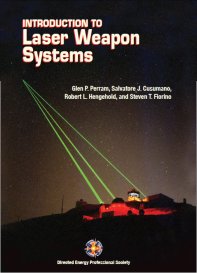This course arises from an almost 40-year history of graduate studies in high-energy lasers and
optics at the Air Force Institute of Technology. In particular, a series of short courses for scientists and engineers
new to the Field of directed energy have been developed as summaries of graduate courses in lasers, optics,
spectroscopy, atmospherics, systems engineering, and electro-optics. More recently, the Directed Energy
Professional Society, with funding from the High Energy Laser Joint Technology Office sponsored the development
of a 32-hour short course entitled Laser Weapons Systems. This textbook parallels the material presented in the course.
This text is primarily intended for scientists and engineers with a bachelor of science degree. However, many
undergraduate students and non-degreed technicians often find the more conceptual material valuable. The course
emphasizes concepts, terminology, current technology capabilities, and systems concepts. The course does not
develop key relationships from first principles. Limitations on the effectiveness of HEL weapons and key performance
trade-offs are addressed. Applications of these concepts to current systems include the historical Airborne Laser
Laboratory, Airborne Laser, Tactical High-Energy Laser, Advanced Tactical Laser, and Space-Based Laser programs.
The course includes a number of extended worked problems, including simplified calculations of weapon effectiveness
for a high altitude, long-range, air-to-air engagement and a short-range tactical scenario.
The text covers a broad range of technical disciplines, some at considerable depth, making a reasonable course
for graduate students. In a few chapters, the prerequisites in spectroscopy, chemical kinetics, optics, or laser
physics may be challenging to the casual reader.
Many faculty members, research staff, and students at the Air Force Institute of Technology have contributed
materials and ideas to this work, including William
F. Bailey, Richard Bartell, Matthew Krizo, Matthew Goda, Mark Houle, Michael Marciniak, Won B. Roh, David W.
Weeks, J. Jean Cohen, Brian Elliot, Christopher Cummings, Ryan Heap, Jamin McCue, and Victor Velten. In addition,
several collaborators from other academic institutions deserve considerable credit, including Paul Merritt,
Jerry Clark, Peter Burban, Steven Gollmer, and Otis Wright. In-house editor Taylor Thompson tirelessly compiled,
coordinated, and incorporated numerous changes, updates, and improvements. We also thank Sam Blankenship,
executive director of the Directed Energy Professional Society for his encouragement and support.
The authors particularly appreciate the comments and revisions suggested by the technical reviewers of this
text: John Albertine, John LeWellen, Paul Merritt, Nicholas Morley, Sean Ross, and Don Seeley. Their contributions
to the accuracy and clarity of this document were essential.
Finally, a special note of thanks is extended to Ed Pogue, prior director of the High Energy Laser Joint
Technology Office, for his vision to involve the military schools in developing high-energy laser modeling and
simulation tools. The integration and balancing of the diverse interdisciplinary material is largely a result
of our experience in leading the HEL JTO’s laser weapon engagement modeling.

